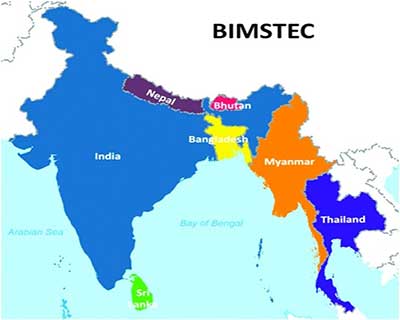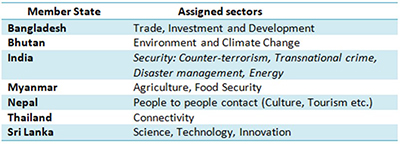Relevance: GS 2: Bilateral, regional and global groupings and agreements involving India and/or affecting India’s interests.
Key Phrases: Bay of Bengal Initiative for Multi-Sectoral Technical and Economic Cooperation (BIMSTEC), Bangkok Declaration, South Asian Association for Regional Cooperation(SAARC), BIMSTEC Development Fund, Act East policy, Bay of Bengal Community (BOBC)
Why in News?
- June 6 marked the completion of 25 years since the 1997 Bangkok Declaration launched a modest grouping (of Bangladesh, India, Sri Lanka, and Thailand), with the acronym, BIST-EC.
- Three countries (Nepal, Bhutan, and Myanmar) joined it later to make it the Bay of Bengal Initiative for Multi-Sectoral Technical and Economic Cooperation (BIMSTEC).
Past Trajectory
- Slow Growth:
- At the grouping’s birth, the world was different; it was stamped by America’s ‘unipolar moment’.
- India and Thailand joined hands to start an experiment of infusing a part of South Asia with the economic and institutional dynamism that defined the Association of Southeast Asian Nations (ASEAN).
- But BIMSTEC found the burdens of South Asia too heavy to carry, and so it grew slowly.
- Rejuvenation of BIMSTEC:
- In the third decade of the 21st century, the strategic contestation between the United States and China defines the region’s geopolitics and geo-economics, creating new tensions and opportunities.
- Since its Kathmandu summit in 2018, it is viewed as an instrument of regional cooperation and integration, not just of sub-regional cooperation.
- The far-reaching decisions taken, in Goa Summit, paved the way for the institution’s reform that took shape at the Kathmandu summit. The Colombo Summit in March 2022 put its stamp of approval on it.
Do you know?
- BIMSTEC is a multilateral regional organisation established with the aim of accelerating shared growth and cooperation between littoral and adjacent countries in the Bay of Bengal region.
- It was founded as BIST-EC, in June 1997, with the adoption of the Bangkok Declaration, with Bangladesh, India, Sri Lanka, and Thailand as members.
- It became BIMST-EC (Bangladesh, India, Myanmar, Sri Lanka, and Thailand Economic Cooperation) with the entry of Myanmar in late 1997 and eventually, it was named in its current form, when Nepal and Bhutan became members in 2004.
- The first BIMSTEC Summit was held on July 31, 2004 and BIMSTEC headquarters are in Dhaka, Bangladesh.
- The BIMSTEC region hosts 22% of the world population or 1.68 billion people; and the member States have a combined GDP of US$ 3.697 trillion/per year.
Key Achievements of BIMSTEC:
- New Charter:
- It has crafted a new Charter for itself, spelling out the grouping’s vision, and functions of its constituent parts, and has secured a legal personality.
- Prioritized the Sectors of Cooperation:
- It has reduced them from 14 to 7, with each member-state serving as the lead country for the assigned sector.
- Strengthening Secretariat:
- Measures were taken to strengthen the Secretariat, although some members are yet to extend adequate personnel support to it.
- Regular Summits:
- Unlike the South Asian Association for Regional Cooperation (SAARC) and Indian Ocean Rim Association (IORA), post-2014, BIMSTEC has continued to hold its summits and meetings of Foreign Ministers.
- Since its establishment in 1997, BIMSTEC has succeeded in holding five summits so far; it has now resolved to hold regular summits once in two years.
- Security and Humanitarian Cooperation:
- The grouping has also registered progress in combating terrorism, forging security cooperation, and creating mechanisms and practices for the better management of humanitarian assistance and disaster relief.
- Economic Cooperation:
- Memoranda of Understanding, agreements, and legal instruments provide the foundation for developing functional cooperation in select areas such as agriculture, trade, sustainable development, and connectivity.
- Sectoral Cooperation:
- Institutions such as an Energy Centre and the Centre on Weather and Climate are in place to push sectoral cooperation forward.
Fault Lines in BIMSTEC:
- NO FTA:
- A major failure relates to the continuing inability to produce a comprehensive Free Trade Agreement (FTA) 18 years after the signing of the Framework Agreement.
- Heads of State and government need to assert their authority or abandon the FTA as an unachievable goal.
- Connectivity Issues:
- Only limited progress has been achieved so far, despite the adoption of the Master Plan for Connectivity supported by the Asian Development Bank (ADB).
- Much of the connectivity established recently is the outcome of bilateral initiatives taken by India, Bangladesh, Nepal, and Bhutan to strengthen transport links.
- Mega-projects aimed to improve connectivity between India and Myanmar (and Thailand) have been delayed inordinately.
- For greater regional connectivity, more financial resources are needed. The movement towards establishing the BIMSTEC Development Fund is minimal.
- Blue Economy:
- The grouping has talked about the Blue Economy but is yet to begin any work on it.
- BIMSTEC members are yet to build a shared and lucrative coastal shipment ecosystem and also grapple with the frequent detention of fishermen who cross territorial borders.
- Limited Engagement:
- Business chambers and corporate leaders are yet to be engaged fully with the activities of BIMSTEC.
- This leaves the grouping largely in the hands of officials and experts.
- The involvement of the ‘Third Space’ needs to be expanded significantly.
- Lack of efficiency and “sluggish” pace of BIMSTEC’s progress:
- The inconsistency in holding policy-making and operational meetings was mentioned earlier.
- BIMSTEC secretariat also suffers from inadequate financial and manpower assistance for its operational activities.
- Emerging Challenges:
- The BIMSTEC region witnessed the influx of over a million Rohingya refugees into Bangladesh, the result of oppression by the Myanmar military; the coup in Myanmar that led to its virtual boycott by a large segment of the international community; and the grave political and economic crisis afflicting Sri Lanka.
- Selective Interest:
- India has a selective interest in BIMSTEC each time SAARC is hamstrung due to Pakistan.
Do you know?
- Kaladan Multimodal Project – links India and Myanmar.
- Asian Trilateral Highway – connecting India and Thailand through Myanmar.
- Bangladesh-Bhutan-India-Nepal (BBIN) Motor Vehicles Agreement – for seamless flow of passenger and cargo traffic.
Significance for India:
- It allows India to pursue three core policies:
- Neighbourhood First – primacy to the country’s immediate periphery
- Act East – connect India with Southeast Asia
- Economic development of India’s North-eastern States – by linking them to the Bay of Bengal region via Bangladesh and Myanmar.
- BIMSTEC aligns with its ‘Act East’ policy for greater regional cooperation in Southeast Asia.
- It could also be seen as aligning with India’s larger goal to gain trade and security prominence in the Indian Ocean region and to cater to the concept of the ‘Indo-Pacific’ region, a major focus of Quad countries.
- The Northeast States share a border with four BIMSTEC nations namely, Bangladesh, Bhutan, Nepal, and Myanmar. Through, better transportation and border infrastructure North-east present a significant opportunity for India to strengthen its position in the region.
- Allows India to counter China’s creeping influence in countries around the Bay of Bengal due to the spread of its Belt and Road Initiative.
- Except for India and Bhutan, all BIMSTEC nations are part of the China-led BRI (Belt and Road initiative). India which is also the largest economy in BIMSTEC can work as a leader and develop a roadmap on these critical issues along with the members.
- A new platform for India to engage with its neighbors with South Asian Association for Regional Cooperation (SAARC) becoming dysfunctional because of differences between India and Pakistan.
- BIMSTEC can become a common place for peace and development.
Conclusion:
- An exciting destiny awaits it as it works to realize the vision
of the Bay of Bengal Community (BOBC).
- In this Indo-Pacific century, the BOBC has the potential to play a pivotal role, deepening linkages between South Asia and Southeast Asia.
- It should accelerate the region’s economic development by
collaborating with the newly minted Indo-Pacific Economic Framework for
Prosperity (IPEF).
- New synergy should be created between BIMSTEC and the IPEF.
- While all member-states are equal, three have a special responsibility:
- Bangladesh as the host of the BIMSTEC Secretariat;
- Thailand as the representative of Southeast Asia; and
- India as the largest State in South Asia.
- This trio must be the engine to pull the BIMSTEC train with imagination and determination.
Source: The Hindu
Mains Question:
Q. Discuss the role of BIMSTEC as a natural platform to fulfill India’s key foreign policy priorities.









